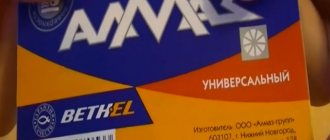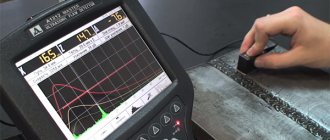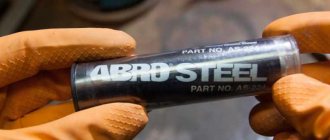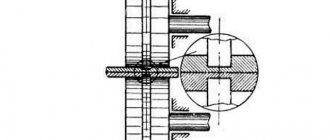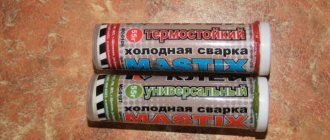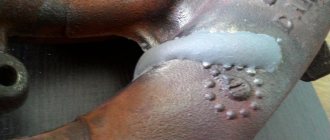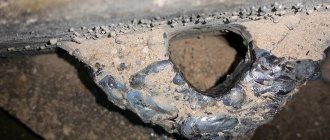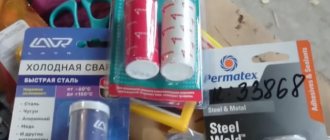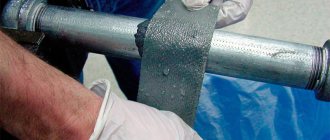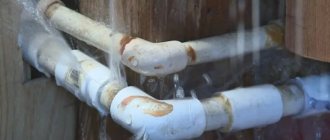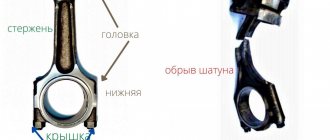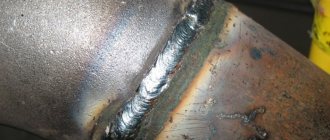Characteristics and composition of cold welding
The main characteristics of cold welding are:
- Presence and composition of filler.
- The initial drying time is the so-called time. “setting”, during this time the composition must be applied to the gluing area and leveled.
- Final curing time - the product cannot be used before this period.
- Application temperature - the recommended temperature at which the mixture can be applied to the surface.
- Maximum operating temperature.
The plastic cold seal adhesive composition can consist of one or two components. Its required components are:
- The adhesive base is in the form of epoxy resin, which determines the plastic properties.
- The filler is metal powder, evenly distributed throughout the volume.
- Quality improving additives, such as sulfur.
The quality of a weld obtained by cold welding depends on conditions such as:
- Quality of adhesive material.
- Preparing the surfaces of parts for gluing.
- Compliance with technology.
The strength of the resulting seam in real conditions will be lower than that of a seam produced by the hot method.
Therefore, the technology is best applicable for local repairs of lightly loaded products.
Technical information about products of individual brands
Cold welding is produced by companies all over the world. They differ not only in country of origin and brand, but also in characteristics.
The birthplace of the brand of epoxy glue-plasticine Contact is Russia, and the product is produced in China. Cold welding was developed for joining alloys and metals. It consists of two main components: hardener and epoxy resin. Using Contact glue-plasticine, you can seal joints and return parts to shape. It is not affected by water and solvents. Welding for metal can hold temperatures from -30 to 160 degrees. The adhesive guarantee is 12 months. The quality, with proper further use, does not change after time. Mix the glue-plasticine with your hands wearing protective gloves. Does not work on materials such as Teflon and polyethylene. In addition to alloys and metals, you can glue wood, concrete, glass, and porcelain.
For reliable connection of various materials, “Epoxy-titanium” made in Russia is suitable. Consists of two components: epoxy resin and hardener. Available in the form of a viscous liquid, which is suitable for metals, ceramics, plastics, and precious items. Works effectively for a variety of holes and cracks. The composition is resistant to vibration, gasoline and acid. To harden at 20 degrees, this cold welding needs 3-4 hours. Withstands high temperatures (up to 1200 C).
American cold welding Hi-Gear fast steel is a two-component adhesive mass (putty) with metal chips. It is used when working with plastic, wood, metal, cast iron, stone and other materials. For this cold welding, the operating temperature can reach up to 260 degrees. Also used for vehicle repairs.
Aluminum-filled metal plasticine KR-115 is a composition with high viscosity, consisting of two components. Suitable for welding non-ferrous metals. Typically used for professional repair of auto parts and restoration of household products. KR-115 is not affected by gasoline and water. Hardening of the mass begins within the first half hour. Can be frozen for a long time without loss of effectiveness.
Poxipol is a two-component product that is available in two colors - transparent and regular. The cost in different online stores for tubes weighing 16-25 grams varies from 250 to 450 rubles. Poxipol is used for gluing granite, reinforced concrete, metals, wood, marble, etc. To wait for initial drying, 15-20 minutes is enough. Along with the product, manufacturers include special trays in the packaging on which the two-component mass can be mixed.
Abro dry cold welding can withstand temperatures up to 260 degrees. This composition can be used to repair wooden, metal, glass and ceramic products. Abro is often used by mechanics and car enthusiasts to fix body parts, fuel tanks and more. It is also actively used for plumbing purposes due to its ability to expand during the hardening process.
Not all cold welding products that are presented on the construction market are distinguished by reliability and quality. Therefore, it is worth choosing proven options.
The compositions described above have many positive user reviews. You can easily verify this by simply entering the name of the product in a search engine.
How to use cold welding correctly
To obtain a good seam, careful execution of the following steps is of utmost importance:
Technological process of cold welding
- Clean the bonded surfaces from oil, fat and mechanical contaminants. Cleaning can be mechanical (abrasives, steel brush), chemical (solvents and degreasers) and combined.
- All actions are carried out only in protective gloves.
- Squeeze the two-component composition out of the tubes and mix the components well.
- Separate the required amount of plasticine-shaped composition from the block with a spatula and carefully close the remaining block.
- Knead the composition. It should heat up slightly, maintaining plasticity; once the required consistency is achieved, apply the mixture to the surfaces to be glued.
- Securely press the surfaces together by wrapping the parts with an elastic band.
- If pipes are being repaired, the composition must be applied with several smoothing movements.
- After the time specified in the technical specifications as the initial drying time (90% of the glue sets), the tourniquet can be removed.
- The repaired product can only be used after the final hardening time has passed, usually 24 hours.
It is better to remove the remaining adhesive with a spatula after applying and applying the tourniquet. If they have already hardened, they can be removed by lightly tapping them with a hammer.
Differences from other varieties
Cold welding is considered a glue, although according to its technical characteristics it is an independent product. The main difference of the product is that it is non-flammable, waterproof and resistant to high temperatures . Most adhesives cannot boast of similar properties. Cold welding acquires its properties regardless of the thickness of the applied layer. This allows it to be used to eliminate mechanical damage. It is enough to apply a layer of sealant to the damaged area and wait for it to harden. After hardening, the repair surface must be processed.
Temperature characteristics
The composition of the adhesive mass determines what temperature cold welding can withstand. The user manual always states this value. If you carefully follow all the requirements of the manual, the seam will withstand this temperature without loss of strength.
Budget brands are usually developed for a maximum temperature of around 260 C. Special types of mixtures have a maximum operating temperature of over 1300 C. They cost significantly more, but they allow you to repair parts and products operating at high temperatures. This is an excellent help if the use of hot technology is difficult for reasons of fire safety or accessibility of the repair site.
Types of cold welding
The following types are used:
- Spot. For connecting aluminum and copper conductors, gluing copper ends to aluminum wires.
- Suture. For the production of thin-walled vessels, sealed containers and equipment casings.
- Butt. For connecting wires or ring-shaped products.
- Tavrovaya. For connecting elements of rolled profiles.
- Shifting. For connecting pipes of heating or water supply circuits, as well as components of electrical distribution networks on railways.
Depending on the packaging method, there are:
- Liquid Weld - Supplied as two separate components, a plasticizer and a hardener, which are mixed before use.
- Plasticine-shaped, supplied in the form of a bar, which is kneaded and mixed before use.
Two-component cold welding is more difficult to use, but is more economical in use.
Plasticine cold welding
Liquid cold welding
According to their intended purpose, they are distinguished:
- liquid welding for metal is used for gluing most metals and contains a filler in the form of metal powder;
- liquid welding for car repairs, characterized by increased resistance to vibrations, also contains a filler;
- universal, connecting metals, wood or plastic in any combination. The strength of such a connection will be low;
- for work in special conditions, such as underwater, high-temperature, aggressive environments, etc.
Heat resistant cold welding
Heat-resistant cold welding is very popular among car enthusiasts who repair mufflers and other exhaust system elements.
Definition, purpose
In this article we will take a detailed look at such a universal and modern tool as “Cold Welding”, describe in detail the areas of application and analyze all the nuances when using it. Many ordinary people, having heard this definition, probably become confused - what is it and how can welding even be “cold”? Essentially, this is a special adhesive putty used to connect various parts, based on epoxy resin and filler, which is responsible for strength and heat resistance. The metal powder in the filler makes the seam, after it dries, look like a weld. This is where it takes its name from.
I want to say right away so that you don’t get confused in the future, such a concept as “Cold welding” is also found in industry, where soft metals are joined under high pressure; this technology, except for the name, has nothing in common with our glue.
This product is widely used in the field of repair work during the operation of transport, pipelines of heating systems, water supply and plumbing. Simplicity and efficiency in operation, without the use of special equipment, allows you to quickly and efficiently deal with problems that arise.
Cold welding does an excellent job of eliminating holes and holes, for example in a gas tank, radiator, muffler and other small defects on metal surfaces; it can also be used to restore threaded connections by creating copies of the missing bolts - to do this, just sculpt the desired shape and, while the mass did not have time to harden, cut the thread with a regular nut.
It is worth noting that this type of welding is optimal in conditions where the parts being joined do not bear heavy loads during operation. Unlike a traditional seam made by a professional welder, the adhesion produced by cold welding will be significantly lower. Therefore, this remedy is, although reliable, but a temporary solution that will allow you to stop the leak or get to a service center, where it will be possible to make a major repair. This is why you need to clearly understand the goal you want to achieve as a result of your work. If, for example, you want to weld a battery, close small holes, repair pipes in the house, and so on, then cold welding will not only suit you, but will also be much more convenient to use than its ordinary counterpart. However, if you think that there may be a physical impact on the part, then it is better to use ordinary welding in order to prevent a situation where your work will be in vain due to the use of force on the seam.
Tips for using cold welding
In private life, the method is most often used for car repairs and heating systems. A leaky and sealed muffler or gas tank will serve for many years without requiring replacement.
Unfortunately, the radiator can only be patched up temporarily in this way in order to get to the service station under its own power. It will not be possible to use it constantly. If the location of the leak cannot be determined, you can lower the radiator into a bath of water. Emerging bubbles will indicate the location of the leak.
To repair a muffler, you need to choose a high-temperature brand. If the instructions indicate room temperature for use, then you should wait until the part has cooled before starting repair work.
If you are repairing a heating system, you should choose a composition that can withstand prolonged contact with water. It should be remembered that the method is suitable for repairing small holes. If the damage is significant, it is better to use hot welding.
The method is categorically unsuitable for gluing parts operating under heavy load.
You should not try to replace the brand developed for a specific material with the one you have on hand. The filler must exactly match the materials being glued, otherwise the strength of the seam can be forgotten.
Advantages of cold metal welding
The technology has undeniable advantages:
- Zero electricity or gas consumption.
- A neat and durable seam does not require further processing.
- There is no need for lengthy training or special equipment.
- Makes it possible to firmly connect different metals, for example, aluminum and copper, which are practically not connected by other methods.
- Makes it possible to repair parts and pipelines without dismantling them, not only in a cold, but also in a hot state.
- Repair of live electrical installations, containers and pipes under low pressure and even with flammable materials.
- There are no deformations caused by residual stresses in the metal that arise after hot welding.
- Highly environmentally friendly process, no hazardous waste.
Neat seam of cold welded linoleum
In addition to all of the above, low labor intensity and low price of consumables make the method economically profitable.
Security measures
The components that make up the mixture are highly chemically active and strongly irritate the skin and mucous membranes. If ingested, they cause life-threatening poisoning. Therefore, when working, it is necessary to strictly observe safety measures:
Be sure to wear rubber or plastic gloves
- Be sure to wear rubber or plastic gloves.
- When working with a plastic compound, be sure to test the effect of the components on the glove material. If they dissolve, gloves should be taken from a different material.
- Wear safety glasses or a transparent protective shield. It is especially important to observe this point when working from below the object being repaired - a car, pipeline, etc., in order to prevent pieces of the substance from getting on the face and mucous membranes of the eyes and mouth.
- In case of accidental contact with skin, rinse immediately with plenty of clean running water.
- In case of ingestion, drink plenty of fluids, preferably milk, and consult a doctor immediately.
- Keep away from children! Playing with a plasticine-like substance can end in a hospital or morgue.
- Do not use for repairing dishes and containers that come into contact with food.
After hardening, the components of the mixture lose their chemical activity and are absolutely safe to touch with your hands.
How to fix a leak in a pressurized water pipe
- If a pipe is leaking when the coolant pressure is low, then an ordinary iron pipe clamp to eliminate the leak is a sure and quick solution to eliminating a leak in the heating system. The factory clamp is a round metal structure with a wall thickness of 1-1.5 mm, rubberized on the inside and equipped with a bolt and a nut for tightening (or a pair - depending on the width of the clamp);
- People's advice on how to seal a leak if there is no steel clamp: wrap the accident site with rubber from a bicycle tube, a pharmaceutical bandage, or any suitable piece of rubber, for example, a rubber glove. You can secure such a homemade clamp with wire, or wrap it with any cord;
- In the absence of a factory clamp and rubber, you can make a homemade clamp from tin, even from a tin can lid;
- Even a piece of elastic polymer (for example, vulcan rubber), tightly wrapped with wire, turn to turn, can temporarily save the situation.
Other methods of eliminating an accident if a heating pipe is leaking will not work - only dry surfaces can be sealed with cold welding, although the hardened composite can then work even in water. It will not work to seal a hole or crack with sealing compounds for the same reason - the surface to be repaired must be dry, and preferably clean. Therefore, sealant for heating pipes, epoxy resin, dichloroethane and other fast-hardening composites are used only on disconnected dry sections of the heating route. This also applies to the repair of the water supply line in the water supply pipe for hot water supply or hot water supply.
